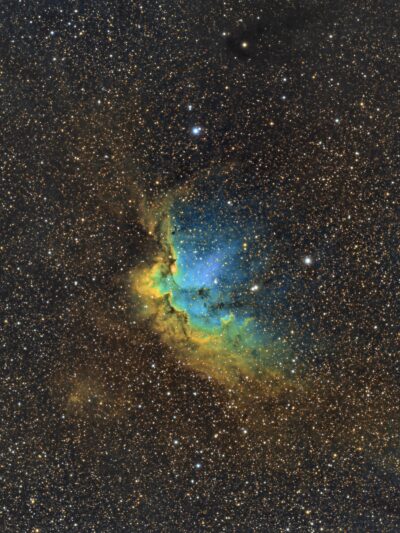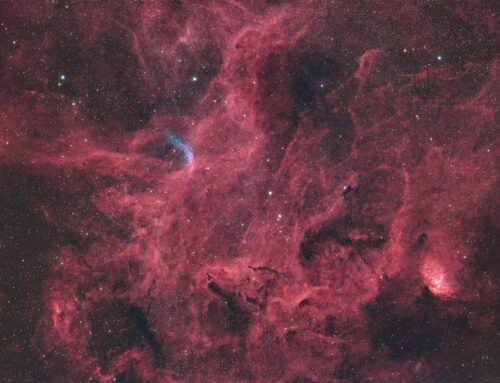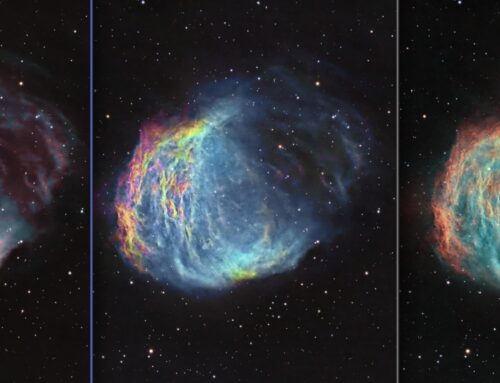The Wizard Nebula
Click image thumbnails for full size versions
October 20, 2020
The Wizard Nebula (Sh2-142) is an emission nebula in the constellation Cepheus, who was a king of Ethiopia. Personally, I don’t see a wizard no matter which way I rotate the picture, but maybe someone can set me straight. The object is made mostly of glowing hydrogen atoms, but other elements like sulfur and oxygen also contribute. Just right of centre is the star cluster NGC 7380, but I find it hard to see against the rich background of the Milky Way. Both the cluster and nebula are a little more than 7,000 light years away, relatively close in cosmic terms. The small patch of nebulosity at lower left is Sh2-143.
The blue-and-gold hued image was taken using narrowband filters that pass only a few wavelengths from sulfur, hydrogen and oxygen, which are mapped to red, green and blue. This false-colour or “tone-mapped” palette is aesthetically pleasing, and reveals structures that broadband natural colour images, like the red-hued image on the right, can’t. Hydrogen and sulfur both emit red light, and can’t be distinguished in the broadband image.
Tekkies:
Acquisition, focusing, and control of Paramount MX mount, unguided, with TheSkyX. Focus with Optec DirectSync motor and controller. Automation with CCDCommander. Equipment control with PrimaLuce Labs Eagle 3 Pro computer. All pre-processing and processing in PixInsight. Acquired from my SkyShed in Guelph. Average transparency and seeing. Data acquired September 18-21, 2020 in a mostly moonless sky.
Narrowband and Luminance: Sky-Watcher Esprit 150 f/7 refractor and QHY 16200-A camera with Optolong UV/IR, H-alpha, O(III) and S(II) filters
Chrominance: Takahashi FSQ-106 ED IV @ f/5 and QHY367C Pro one-shot colour camera with Optolong UV/IR filter
O3: 27 x 10m = 4hr30m
Data Reduction and Cleanup
The WeightedBatchPreProcessing script was used to perform calibration, cosmetic correction, registration and integration of all frames.
Chrominance
Creation and cleanup: The S2, Ha and O3 were combined to make an RGB image. DynamicBackgroundExtraction and BackgroundNeutralization were applied to the image.
Linear Noise Reduction: MultiscaleLinearTransform was used to reduce noise in the RGB image. Layer settings for threshold and strength: Layer 1: 5.0 0.7 Layer 2: 3.5, 0.7 Layer 3: 2., 0.6 Layer 4: 1.0, 0.2 Layer 5: 0.5, 0.1.
Stretching: HistogramTransformation was applied to make a pleasing, bright image, with background set to an intensity of approximately 0.12
Luminance
Creation of Synthetic Luminance: ImageIntegration was used to make a noise-weighted average of the three masters. This was used as synthetic luminance.
Deconvolution: A star mask was made to use as a Local Deringing Support image. A copy of the luminance image was stretched to use as a range mask. Deconvolution was applied (80 iterations, regularized Richardson-Lucy, external PSF made using PSFImage script with about 30 stars).
Linear Noise Reduction: MultiscaleLinearTransform was used to reduce noise in the background areas, using an internal mask to protect bright structures. Layer settings for threshold and strength: Layer 1: 4.0 0.9 Layer 2: 3.0, 0.75 Layer 3: 2.0, 0.6 Layer 4: 0.5, 0.2.
Stretching: HistogramTransformation was applied to make a pleasing, bright image, with background set to an intensity of approximately 0.125.
Combining Luminance and RGB
LRGB Combination: The synthetic luminance was applied to the RGB image using LRGBCombine with default settings.
Additional Processing
Nonlinear Noise Reduction: TGVDenoise was used in L*a*b* mode to reduce noise with a mask used to mainly target the background areas and protect the stars (max. 1000 iterations and convergence selected for both luminance and chrominance).
Contrast Enhancement: LocalHistogramEqualization was applied twice using a mask to select the bright parts of the nebula and protect stars and background. The first pass was with a scale of 50 (max contrast 1.5, strength 0.32, 1 iteration), followed by a scale of 150 (max contrast 1.5, strength 0.22, 1 iteration).
Sharpening: MultiscaleLinearTransform was used to sharpen Layers 2 and 3 with strengths of 0.1 for both. A mask was used to limit sharpening to high-signal areas and to protect the stars and background regions.
Hue Adjustment: The ColorMask script was used to create a mask to select green regions. The green was transformed towards blue, and yellows towards red, using CurvesTransformation’s Hue controls. The Hue channel was extracted from the RGB image was extracted using ChannelExtraction in HSL mode and used to replace the same channel of the narrowband image using ChannelCombination through a star mask, to impart a more natural colour to the brighter stars.
Final Steps: Background, nebula and star brightness, contrast, saturation and hue were adjusted in several iterations using CurvesTransformation with masks as required. ICCProfileTransformation (sRGB IEC61966-2.1; Relative Colorimetric with black point compensation) was applied prior to saving as a jpg.








Very nice, I think I like the SHO best, but I am always envious of your RGB stars.